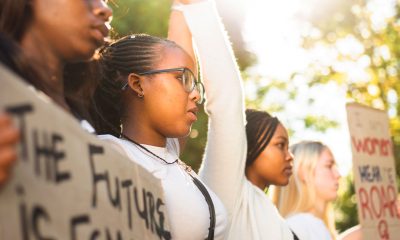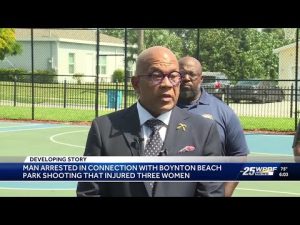#NNPA BlackPress
New Cellphone Video Deepens Concerns about Sandra Bland’s Death
NNPA NEWSWIRE — “When Sandra Bland saw that Officer Brian Encinia had crossed multiple lines, and was there to do much more than simply give her a ticket, she grabbed her phone and began filming him. The video is just 39 seconds long, but it’s literally the most important piece of evidence in the case not just against Brian Encinia, but against the Waller County jail, and the local prosecutors who concealed it.” Activist Shaun King wrote on his blog for Black America Web.
By Stacy M. Brown, NNPA Newswire Correspondent
@StacyBrownMedia
Sandra Bland’s own cellphone video of her 2015 arrest in Texas has raised new questions about the evidence in the case and cast even more suspicion on her alleged jail cell suicide.
To some, the video confirms what they’ve long suspected: Bland was murdered.
“Four years after the brutal arrest and death of Sandra Bland, we just now learned that she filmed her arrest,” Journalist and Activist Shaun King wrote on his blog for Black America Web.
“I’ve shared the video, but I want to unpack and explain who hid it, why, and what the video shows us. Because here’s what we know – across the years – too many Black folk have been killed – and the people set free – based on lies – from Emmitt Till on down,” King said.
Cheryle Renee Moses, a candidate in the 2020 Georgia District 9 Senate Race, took to Twitter to express her outrage.
“The new video released on Sandra Bland’s encounter with a white supremacist confirms the cop was not in fear. Sandra was ready to go to court and I believe she was killed. Period,” Moses said. “There is no way she would take her own life.”
Hope Rising wrote, “[Police Officer] Brian Encinia needs to be in prison. Sandra Bland was murdered.”
Bland’s cell phone video “has been released and we are forced to talk about the issues surrounding her tragic death,” wrote @kiloemcee, one of dozens of Twitter users who expressed outrage after seeing the new video.
“There is more miscarriage of justice in that part of his plea, the officer was allowed to simply walk away from his job. He committed perjury and false arrest,” @kiloemcee wrote.
The video, which surfaced this month and aired on television in Dallas, showed Encinia leaning into the open car door and ordering Bland out of the car.
At one point, Encinia points a stun gun and yells that he will “light you up.”
The cell phone shows that the incident, which occurred on July 10, 2015, concludes with Bland and Encinia outside of the vehicle and him ordering her to cease recording.
Three days later, Bland was found hanging in her cell and authorities ruled her death a suicide.
Dashcam and other cellphone recordings were made public in the weeks after Bland’s arrest and death. However, the newest video raised concerns for the attorney who represented Bland’s family in civil cases, he told the Chicago Tribune.
Cannon Lambert said he and other attorneys had not seen the video in evidence turned over as part of his civil cases, though he thought it could have been due to simple human error.
Regardless, the new video would not have made much of a difference in his civil cases against the state of Texas and the county jail where Bland died, which he settled for a total of nearly $2 million combined, because of legal limits on the amount of money the public agencies could pay, he said.
Rather, the new video raised questions about the special prosecutors’ handling of the criminal charge against Encinia, Lambert said.
“To me, what it really underscores is that the special prosecutors, who apparently had the video before they dropped the charge against Encinia, had ample evidence and opportunity to fully prosecute him like they told the family they were going to, but chose to cut bait and cut a deal,” he said.
Texas Department of Public Safety officials said in a statement they complied with their evidence requirements as part of the civil lawsuit. The video was referenced in a Texas Ranger report, and the report was made available during the civil lawsuit filed by Bland’s family, they said.
Department of Public Safety officials also said they provided the video in 2017 in response to a request from Brian Collister, who then worked for an Austin TV station and who was one of the reporters involved in the story that recently aired on a Dallas TV station that revealed the video.
Lambert said the video shows there was “no basis” to the officer’s initial claim that he was concerned for his safety.
King said the incident all began because of racial profiling.
“This stop was never about turn signals or traffic violations – it was about white power – and it burned him up when he got to the window of Sandra’s car, and saw that she was a proud, informed, strong Black woman – he was completely unnerved,” King said.
“And immediately, it became about power for him. And as soon as Sandra Bland really understood that this wasn’t just a traffic stop, she did something that we never knew she did – the police knew it. Local prosecutors knew it. And for four years they kept this a secret,” he said.
King continued:
“When Sandra Bland saw that Officer Brian Encinia had crossed multiple lines, and was there to do much more than simply give her a ticket, she grabbed her phone and began filming him.
“The video is just 39 seconds long, but it’s literally the most important piece of evidence in the case not just against Brian Encinia, but against the Waller County jail, and the local prosecutors who concealed it.”
While the video doesn’t include her assault, King and others said it’s still painful to watch.
King breaks down facts including that the officer opening Bland’s door was illegal because he didn’t have reasonable suspicion of a crime.
In Encinia’s report, the officer said that he feared for his life and safety with Bland on multiple occasions.
“Of course, that was a lie,” King said.
“And when he said so on his official reports, he committed perjury… Brian Encinia never would’ve opened the car door of a white woman for failure to use her turn signal. He never would’ve taken out a stun gun on a white woman, turned it on, stuck it in her face, and told her he was gonna light her up. He never would’ve slammed a white woman on her head. And we know this because he literally never did any such thing to a white woman in his entire career. I checked,” King said.
#NNPA BlackPress
LIHEAP Funds Released After Weeks of Delay as States and the District Rush to Protect Households from the Cold
BLACKPRESSUSA NEWSWIRE — The federal government has released $3.6 billion in home heating assistance after a delay that left states preparing for the start of winter without the program’s annual funding.

By Stacy M. Brown
Black Press USA Senior National Correspondent
The federal government has released $3.6 billion in home heating assistance after a delay that left states preparing for the start of winter without the program’s annual funding. The Low-Income Home Energy Assistance Program, known as LIHEAP, helps eligible households pay heating and cooling bills. The release follows a shutdown that stretched 43 days and pushed agencies across the country to warn families of possible disruptions.
State officials in Minnesota, Kansas, New York, and Pennsylvania had already issued alerts that the delay could slow the processing of applications or force families to wait until December for help. In Pennsylvania, more than 300,000 households depend on the program each year. Minnesota officials noted that older adults, young children, and people with disabilities face the highest risk as temperatures fall.
The delay also raised concerns among advocates who track household debt tied to rising utility costs. National Energy Assistance Directors Association Executive Director Mark Wolfe said the funds were “essential and long overdue” and added that high arrearages and increased energy prices have strained families seeking help.
Some states faced additional pressure when other services were affected by the shutdown. According to data reviewed by national energy advocates, roughly 68 percent of LIHEAP households also receive nutrition assistance, and the freeze in multiple programs increased the financial burden on low-income residents. Wolfe said families were placed in “an even more precarious situation than usual” as the shutdown stretched into November.
In Maryland, lawmakers urged the Trump administration to release funds after the state recorded its first cold-related death of the season. The Maryland Department of Health reported that a man in his 30s was found outdoors in Frederick County when temperatures dropped. Last winter, the state documented 75 cold-related deaths, the highest number in five years. Rep Kweisi Mfume joined more than 100 House members calling for immediate federal action and said LIHEAP “is not a luxury” for the 100,000 Maryland households that rely on it. He added that seniors and veterans would be placed at risk if the program remained stalled.
Maryland Gov. Wes Moore used $10.1 million in state funds to keep benefits moving, but noted that states cannot routinely replace federal dollars. His administration said families that rely on medical equipment requiring electricity are particularly vulnerable.
The District of Columbia has already mapped out its FY26 LIHEAP structure in documents filed with the federal government. The District’s plan shows that heating assistance, cooling assistance, weatherization, and year-round crisis assistance operate from October 1 through September 30. The District allocates 50 percent of its LIHEAP funds to heating assistance, 10 percent to cooling, 13 percent to year-round crisis assistance, 15 percent to weatherization, and 10 percent to administrative costs. Two percent is used for services that help residents reduce energy needs, including education on reading utility bills and identifying energy waste.
The District’s plan lists a minimum LIHEAP benefit of $200 and a maximum of $1,800 for both heating and cooling assistance. Crisis benefits are provided separately and may reach up to $500 when needed to resolve an emergency. The plan states that a household is considered in crisis if it has been disconnected from energy service, if heating oil is at 5 percent or less of capacity, or if the household has at least $200 owed after the regular benefit is applied.
The District’s filing notes that LIHEAP staff conduct outreach through community meetings, senior housing sites, Advisory Neighborhood Commissions, social media, posters, and mass mailings. The plan confirms that LIHEAP applicants can apply in person, by mail, by email, or through a mobile-friendly online application and that physically disabled residents may request in-home visits.
As agencies nationwide begin distributing the newly released funds, states continue working through large volumes of applications. Wolfe said LIHEAP administrators “have been notified that the award letters have gone out and the states can begin to draw down the funds.”
#NNPA BlackPress
Seven Steps to Help Your Child Build Meaningful Connections
BLACKPRESSUSA NEWSWIRE — Swinging side by side with a friend on the playground. Sharing chalk over bright, colorful sidewalk drawings. Hiding behind a tree during a spirited game of hide-and-seek. These simple moments between children may seem small, but they matter more than we think

By Niyoka McCoy, Ed.D., Chief Learning Officer, Stride/K12
Swinging side by side with a friend on the playground. Sharing chalk over bright, colorful sidewalk drawings. Hiding behind a tree during a spirited game of hide-and-seek. These simple moments between children may seem small, but they matter more than we think: They lay the foundation for some of life’s most important skills.
Through everyday play, young children begin learning essential social and emotional skills like sharing, resolving conflicts, showing empathy, and managing their emotions. These social skills help shape emotional growth and set kids up for long-term success. Socialization in early childhood isn’t just a “nice-to-have”—it’s essential for development.
Yet today, many young children who haven’t yet started school aren’t getting enough consistent, meaningful interaction with peers. Research shows that there’s a decline in active free play and peer socialization when compared to previous generations.
There are many reasons for this. Children who are home with a parent during the day may spend most of their time with adults, limiting opportunities for peer play. Those in daycare or preschool may have restricted free play, and large classrooms can reduce supervision and social coaching. Some children live in rural areas, are homebound due to illness, have full schedules, or rely on screens to fill their playtime. And for some families, finding other families with young children to connect with isn’t easy.
While these challenges can feel significant, opportunities for connection still exist in every community. Families can take simple steps to help children build friendships, create a sense of belonging, and strengthen social skills. Here are some ideas to get started:
- Storytime sessions at libraries or local bookstores
- Community offerings such as parent-child workshops, art, music, gymnastics, swimming, or sports programs
- Weekly events at children’s museums, which may include art projects, music workshops, or science experiments
- Outdoor exploration, where kids can play with peers
- Local parenting groups that organize playdates and group activities
- Volunteer opportunities where children can participate, such as pet adoption events or packing meals at a food bank
- Classes for kids at local businesses, including hardware, grocery, or craft stores
Some of these community activities are free or low-cost and give kids the chance to build friendships and practice social skills. Parents can also model positive social behavior by interacting with other parents and encouraging their children to play with their peers.
These may seem like small moments of connection, but they can have a powerful impact. Every time your child shares a toy, plays make-believe with peers, or races a friend down the slide, they’re not just playing—they’re learning the skills that build confidence, empathy, and lasting friendships. And it’s good for you, too. Creating intentional opportunities for play also helps you strengthen your own network of parents who can support one another as your children grow together.
#NNPA BlackPress
Seven Steps to Help Your Child Build Meaningful Connections
BLACKPRESSUSA NEWSWIRE — Swinging side by side with a friend on the playground. Sharing chalk over bright, colorful sidewalk drawings. Hiding behind a tree during a spirited game of hide-and-seek. These simple moments between children may seem small, but they matter more than we think

By Niyoka McCoy, Ed.D., Chief Learning Officer, Stride/K12
Swinging side by side with a friend on the playground. Sharing chalk over bright, colorful sidewalk drawings. Hiding behind a tree during a spirited game of hide-and-seek. These simple moments between children may seem small, but they matter more than we think: They lay the foundation for some of life’s most important skills.
Through everyday play, young children begin learning essential social and emotional skills like sharing, resolving conflicts, showing empathy, and managing their emotions. These social skills help shape emotional growth and set kids up for long-term success. Socialization in early childhood isn’t just a “nice-to-have”—it’s essential for development.
Yet today, many young children who haven’t yet started school aren’t getting enough consistent, meaningful interaction with peers. Research shows that there’s a decline in active free play and peer socialization when compared to previous generations.
There are many reasons for this. Children who are home with a parent during the day may spend most of their time with adults, limiting opportunities for peer play. Those in daycare or preschool may have restricted free play, and large classrooms can reduce supervision and social coaching. Some children live in rural areas, are homebound due to illness, have full schedules, or rely on screens to fill their playtime. And for some families, finding other families with young children to connect with isn’t easy.
While these challenges can feel significant, opportunities for connection still exist in every community. Families can take simple steps to help children build friendships, create a sense of belonging, and strengthen social skills. Here are some ideas to get started:
- Storytime sessions at libraries or local bookstores
- Community offerings such as parent-child workshops, art, music, gymnastics, swimming, or sports programs
- Weekly events at children’s museums, which may include art projects, music workshops, or science experiments
- Outdoor exploration, where kids can play with peers
- Local parenting groups that organize playdates and group activities
- Volunteer opportunities where children can participate, such as pet adoption events or packing meals at a food bank
- Classes for kids at local businesses, including hardware, grocery, or craft stores
Some of these community activities are free or low-cost and give kids the chance to build friendships and practice social skills. Parents can also model positive social behavior by interacting with other parents and encouraging their children to play with their peers.
These may seem like small moments of connection, but they can have a powerful impact. Every time your child shares a toy, plays make-believe with peers, or races a friend down the slide, they’re not just playing—they’re learning the skills that build confidence, empathy, and lasting friendships. And it’s good for you, too. Creating intentional opportunities for play also helps you strengthen your own network of parents who can support one another as your children grow together.
-

 Activism3 weeks ago
Activism3 weeks agoOakland Post: Week of November 12 – 18, 2025
-

 Activism3 weeks ago
Activism3 weeks agoIN MEMORIAM: William ‘Bill’ Patterson, 94
-

 Activism3 weeks ago
Activism3 weeks agoHow Charles R. Drew University Navigated More Than $20 Million in Fed Cuts – Still Prioritizing Students and Community Health
-

 Bay Area3 weeks ago
Bay Area3 weeks agoNo Justice in the Justice System
-

 #NNPA BlackPress3 weeks ago
#NNPA BlackPress3 weeks agoThe Perfumed Hand of Hypocrisy: Trump Hosted Former Terror Suspect While America Condemns a Muslim Mayor
-

 #NNPA BlackPress2 weeks ago
#NNPA BlackPress2 weeks agoTrump’s Death Threat Rhetoric Sends Nation into Crisis
-

 #NNPA BlackPress4 weeks ago
#NNPA BlackPress4 weeks agoProtecting Pedophiles: The GOP’s Warped Crusade Against Its Own Lies
-

 #NNPA BlackPress2 weeks ago
#NNPA BlackPress2 weeks agoLewis Hamilton set to start LAST in Saturday Night’s Las Vegas Grand Prix





















































